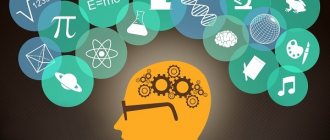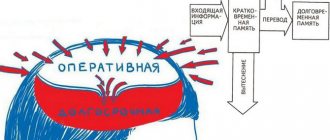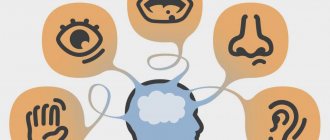In the 21st century, very young people complain about memory. This is not surprising, because the brain has to process huge flows of information every day. As a result, the shopping list, the phone number of the children's clinic, and a friend's birthday literally “fly out of my head.” The worst thing is that manufacturers of high-tech gadgets encourage this order of things. People don’t have to remember a lot of things: phone numbers and birthdays are recorded in smartphones, there are special applications for shopping lists and everyday affairs, and the Internet will help you remember who, for example, Cicero was, in a matter of minutes.
Scientists constantly prove that the capabilities of the human brain are almost limitless. And this applies not only to world-famous geniuses, but also to ordinary people. Each person's memory capacity is individual, but not all of its potential is used every day. Memory development is important not only for schoolchildren and students who have to take exams. Improving memory processes is a kind of training for the brain, which is highly likely to help maintain a clear mind even in old age.
The types of memory and methods of its development will be discussed in this article.
Classification of memory according to the time it saves information
Based on the duration of information storage, they distinguish between instantaneous, short-term (and operational memory, which was previously identified with short-term, but is now more often considered its operational component), and long-term memory.
Instant memory is stored for a very short period of time, up to 3 seconds, and its task is to perceive information from the senses as fully as possible and, without processing, transfer it further to short-term memory.
Short-term memory retains information in a small volume for a short time (about 30 seconds) (on average about 7 objects). At this stage, a decision is made about whether it needs to be transferred to long-term memory. The important thing is that without repetition, information is forgotten over time, “erased.” Short-term memory “selects” from the received data the most important thing, something that can be useful, a certain generalized image.
Random access (working) memory is an active process that allows you to work with information stored in short-term memory, manage it, and organize it. This is a kind of intermediate form of memory (between short-term and long-term), acting depending on a certain period of completion of the assigned memorization task (seconds or days). Once the task is completed, the information is erased. Thanks to this memory, we, for example, pass an exam in an unloved subject, after which sometimes we completely forget everything we have learned. Working memory also manifests itself when, in response to an unexpected question, we not only answer, but also, holding the question in our heads, plan what we will say next, how we will develop our thought. Thanks to it, we remember purchases and roughly calculate the amount, moving towards the checkout, and so on.
Long-term memory can store information for a long time, sometimes throughout life. True, we still need to extract it from storage. For long-term memorization, you need meaningful, well-structured information associated with already “rooted” knowledge.
As a rule, it is the inability to quickly and effectively carry out the work of comprehending new material, structuring it and linking it with existing knowledge that causes difficulties in transferring material from short-term memory to long-term memory and, accordingly, complaints about weak memory . Information placed in short-term memory must be “decoded” in order to be remembered, that is, it must become understandable to our brain.
Our memory consists of four stages
Stage 1. Memorizing incoming information
In our head, the brain works like a recording device; it receives information, remembers it and stores it until the right time.
Stage 2. Information storage
Our brain stores a large stream of information that comes to it every day, it adds it up and stores it until the right moment in time.
Stage 3. Reproducing the necessary information
When you need the necessary information, the brain processes and reproduces the information needed at the moment for you.
Stage 4. Forgetting
Forgetting is the last stage of memory; everything that is not useful is forgotten by our brain and thrown out of our heads. It is better to forget and erase unnecessary information, and make room for the flow of new information.
How to develop memory and what is needed for this?
To develop memory, you need:
- Understand the processes occurring in it and consciously strive to manage them.
- Develop attentiveness, observation and, as a result, improve the skill of searching and finding better and more complex associations.
- Involve different senses in the process of memorization: using several channels, we achieve a systemic effect on memory.
- Create positive motivation.
- Understand that since the entire brain is involved in the process of memory, it is necessary to develop all mental abilities.
- Use various techniques and methods of memorization that mnemonics have.
Using Stress
Negative facts are well perceived under moderate stress. The brain mobilizes resources more effectively, information is also perceived as a threat. The active work of the intellect helps ensure long-term memory. Information loaded into consciousness as important can easily be retrieved later.
Developing intelligence and memory in this way is a subtle tool that not everyone can use. Some people, on the contrary, forget everything that happens in such situations. Therefore, the joint development of intelligence and memory by a group of people in this way is not practiced (for example, by teachers at school). It is known in psychology that the dose of stress is individual for everyone, as is the method of immersion in such a state. The training is carried out according to the following rules:
- choosing a way to deal with stress;
- determination of its dose (with short duration);
- monitoring the period of effective brain function;
- the whole process is controlled.
You can put your hands in cold water or remember a bad situation, which you then attach information to remember. A quarter or half an hour after the sensations are received, the material is mastered calmly, after which memory parameters deteriorate.
What do you need to know to remember better?
How can we make the information coming to us “layer” on top of what we have already received, combining with it in order to replenish and enrich our knowledge, “pack” into long-term memory and extract it from it as needed? This question has long occupied psychologists and educators, and research has identified some general principles that help the memorization process:
- We remember better what we do on our own: in the process of doing it, we have to use attention and thinking, that is, we have to think through and then consciously consolidate in practice what we need to remember. In the process of this work, “inconsistencies” that were not immediately realized in the process of perception are identified; clarification of misunderstood points fills gaps in understanding and helps to consciously consolidate the material in memory.
- We remember better if what we need to remember meets our needs, is interesting, important and can be useful. Otherwise, even repeated repetition will not bring quality results.
- We remember better if we understand. At the same time, understanding and comprehension must be united, and you need to remember after understanding and comprehension in order to build an overall picture. Otherwise, memorized individual details and wording may distort the perception of the full picture. The fact is that understanding and memorizing are two different tasks, and attention “splits” between them, which complicates memorization. At the same time, meaningful and understood material may not be well established in memory if it is not revisited. Moreover, the repeated appeal must be active. For example, you can retell what is meaningful and remembered.
- Retelling is a great way to determine what was remembered and what was not, focusing on what was missed during the retelling. Research results indicate that memorization productivity is much higher if, for example, you do not read the material three times and reproduce it, but read it, reproduce it, read it again with an emphasis on what was missed during the retelling, and only after that reproduce it again.
- How not to forget what you have learned? For example, what if you need to learn it by heart? The best result will be achieved if you follow this scheme: the first repetition - 15 minutes after learning, the second - after 8 hours, the third - a day later. Before bed and in the morning are the best times to repeat.
- It has been noticed that when studying material, information presented at the beginning and at the end is better remembered (the so-called “edge effect”), so information located in the middle needs more careful and in-depth study. When presenting material, it makes sense to place what is most important at the beginning or at the end: this way it will be perceived better.
- It is much more effective to remember material if you study it a little every day, rather than trying to “storm” with a long and tedious lesson in one day.
- It has been proven that for the best memory of information, breaks between intense mental activities are necessary. Moreover, you need to rest, without switching to the perception of other material, that is, try not to “hang out” on the Internet, for example, but to walk, move, and warm up a little. Thus, before moving from studying one complex task to another, you need to give yourself a 15-minute break, otherwise retroactive inhibition occurs. During the rest period, the effect of inhibition is removed, and you again become able to actively remember.
Based on the characteristics of memorization, we can formulate 9 practical tips to help expand the capabilities of our memory.
Using emotions as a method to improve memory
Other recommendations for memory development include matching the information being remembered with emotions. This way you can master quite large volumes of it. In a cheerful mood, positivity is easily perceived. And it is better to memorize sad texts in a melancholic state; the process of assimilation is more successful. If you need to master information in the near future, you need to change your mood to match it. Music for developing such skills can be very useful, because it can be chosen according to the circumstances.
Auxiliary exercises for memory development
When deciding how to develop memory, we must understand well: short-term memory lays the foundations for long-term memory, which is a component and gradually increases a person’s personal knowledge and experience. To train long-term memory, the skill of concentration is necessary; its volume and stability are very important.
Mindfulness training exercise
It is better to start learning to concentrate with mindfulness training, that is, you first need to learn to concentrate on the current moment, without being distracted by emotions, extraneous thoughts and feelings. Such exercises train the brain and short-term memory and, most importantly, help maintain concentration, preventing it from dissipating even under stress.
Start small - with a sense of yourself “here and now”. Straighten your back, sit comfortably, and focus on your breathing. Feel how the air enters your nose, listen to the movements of your body. If thoughts appear about something other than your feelings at the current moment in time, just start over without getting upset or distracted by them. Become the master of the current moment.
Concentration exercise
Fix your attention on an object, for example, on the hand of a clock. For a given time (from 1 to 5 minutes), without being distracted by anything, follow the arrow. As soon as you notice that a distracting thought has arisen in your head, and you are already thinking about something instead of following the arrow, start again.
Self-control exercise
It may be more difficult to stay in a state of free observation, in which you notice all the emotions, sensations and thoughts, but do not let them take over you, but simply notice and let go. The goal of this practice is to learn to notice the moment when you are distracted and consciously return your attention.
Learning speed reading is absolutely not a pain
Teaching speed reading techniques is based on a serious scientific basis. It was developed with the participation of psycholinguist V. Leontyev and psychologist L. Grimaki.
This truly effective technique, where science and methodology is involved, significantly improves the principle of speed reading and memory development.
Experts say that there are five shortcomings in the traditional reading method that prevent people from mastering speed reading, and memory development is significantly reduced:
- How to develop memory and attention if users of the traditional reading method often use backward eye movement (regression) to re-read text that is not entirely clear? How can memory and attention develop in such a rhythm?
- Lack of a flexible reading program, when texts are read equally slowly, even if some of them require quick reading.
- The main obstacle to fast reading is articulation, that is, the sound of the text while a person reads it to himself. Many people mentally recite the text while they read. This defect takes up too much of the reader's time. This is the most difficult defect to correct, but thanks to the speed reading program, it is corrected over time.
- The fourth disadvantage is that people have a small field of view when reading. This is the area that is perceived by the eyes at the fixation (stop) stage.
- Lack of attention, which is a catalyst for the reading process. Without attention there is no fast reading. That’s why memory development and speed reading are so interconnected. After all, memory cannot exist without attention either.
How to develop short-term and working memory
RAM is our “workhorse”, and its insufficient development (namely, difficulties in retaining a sufficient number of pieces of information, less than 7-9) brings a lot of trouble: it is difficult for us to work with the material, because we lose our thoughts, it is difficult for us to retain information in memory without errors, it is difficult for us to systematize the material and keep up with learning as quickly as it happens for those whose memory is better developed. We don’t trust our memory and find ourselves in a vicious circle: the less we trust it and the less we use it, the less likely we are to achieve the goal of memory development.
Memory capacity, i.e. the number of units of information that it is able to retain can and even needs to be increased. The following exercises contribute to the development of short-term and operational memory:
- Execute n-backward task. This perfectly develops the volume of working memory, especially when observing a gradually increasing load.
- Performing mental calculations. Forget about the calculator at least for a while, practice counting in your head. It's easier to do this in a playful way.
- Classes with Schulte tables are a search in special tables for the sequence of numbers scattered in them for a specially designated period of time.
- Completing puzzles also helps improve memory, develops meaningfulness and objectivity of perception, analysis and synthesis. If you don't have a box of real puzzles on hand, you can use online games.
Scientists from Rutgers University (USA), conducting experiments with a large group of mice, found that mice that had recently completed a maze passed such a test more successfully, more confidently, and faster than others. These and similar tests confirmed that mental loads that increased the amount of working memory (without the participation of long-term memory) clearly increased the cognitive abilities of the subjects.
How to develop long-term memory
To develop long-term memory, you need to follow the laws to which it obeys, and which we mentioned above (comprehension, interest, amount of knowledge, readiness to remember, simultaneous impressions, strengthening the first impression, inhibition (forgetting)).
How to develop memory by reading a book? After reading, try not to put the book aside, but do the following: carefully review its table of contents, recalling the events associated with each chapter. Perhaps you would title the book differently? Think about what name, what image would combine your impression of her? “Encode” the book this way. By paying attention to it, you will better remember both the title and content.
Adviсe:
- It is recommended to repeat information that needs to be remembered for the exam 3 days before taking it according to the following scheme: 1st repetition - after reading and understanding, 2nd - 20 minutes after that, 3rd - after 8 hours, 4th - after a day, and better at night.
- Retell important information or verses that you want to remember forever the next day, then after 3 days, then after 7 days and finally after a month.
- Bob Sullivan and Hugh Thompson, American memory researchers, propose for this purpose using the following scheme for repeating material: after 5 seconds, then after 25 seconds, then after 2 minutes, then after 10 minutes, then after an hour, again - after 5 hours, then after 1 day, after 5 days, after 25 days, after 4 months, after 2 years, and so on.
The habit of remembering what you need is a skill that needs to be developed. We can increase the amount of memory, but this requires effort: we need to learn to concentrate on a task, highlight the main thing, actively reproduce the necessary information, use mnemonics, and discipline the intellect. It’s much easier to give up and blame “bad memory.” But it’s much more interesting to try again and again and discover a gradual improvement in perception, attention, and memory. However, it is important to be tolerant of yourself and not give up when encountering difficulties.
Organization of attention
By carefully concentrating, a person is able to remember a large amount of information with details and details. Consciousness acts selectively, focusing on the most important. To train in a calm state, you need to try to remember an object or a drawing on it - the development of visual memory. Next time we’ll train on complex equipment: we’ll list the functions of a mobile phone. By developing the habit of making descriptions, a person trains attention and observation, improving the ability to remember.
Why do you need to take into account the features of your memory?
We are all different and remember information differently. It is easier for some to perceive information by ear, for others it is necessary to read it, that is, to see it, and for others it is necessary to read it, always emphasizing it, and say it out loud. Sometimes it is the smell that brings back memories of long-forgotten events. As a rule, some type of figurative memory (the so-called memory for images formed in the process of perception and helping us remember, imagine the image of what was perceived) dominates. Based on it, it is easier for us to remember the material. Your task is to understand how this happens for you and to put into practice the strengths of your perception and memory. But remember: when memorizing, the first stage is concentration.
Thus, tables, diagrams, and visual aids help those with good visual memory. While listening to a lecture, it is advisable for them to take notes and notes. It is preferable for them not to listen to others read, but to read themselves, highlighting the most important passages.
Those with good auditory memory should especially avoid sound interference and irritants when working with material that needs to be remembered. They need silence to concentrate and remember. They memorize the lecture “vocally” and strengthen their memorization by retelling what they remember out loud and reasoning out loud. Notes help them, of course, but rather because this also involves visual (figurative), motor, verbal-logical, and possibly emotional memory, enhancing each other’s effect.
Those with good motor (motor) memory remember through movement, therefore, by drawing diagrams and graphs, taking notes, and performing practical tasks, they remember the material more easily.
How to develop visual memory
To develop visual memory, you need to learn to notice the smallest details. Developing the skill of such memorization will require mental effort, but gradually memorization will begin to occur as if automatically. What needs to be done for this?
- Cultivate the habit of carefully examining something in detail (for example, a painting, a picture, objects on a table, the contents of a box, the interior, the appearance of someone or something). Allow a certain time for this exercise, for example 30 seconds. Your task is to remember everything you saw as completely and in detail as possible and describe it, trying not to miss anything. Try to mentally “see” the picture you were supposed to remember.
- Before going to bed, try to mentally “see” what happened during the day, or within a few hours, trying not to miss anything.
- Try to mentally “see” the page you just read or an episode from a movie you watched.
- Remember more distant events, try to remember what happened a little before an event, during it and a little later: remember the chain of events, restore it in your memory like a film.
- Try playing memory matrix games.
It’s worth talking separately about some of the techniques we know for memorizing material:
- Mechanical repetition. It should be remembered that mechanical memory, devoid of comprehension, does not bring the desired result, and a lot of effort and time is spent on memorization. However, entire generations memorized poems for the rest of their lives by repeating them out loud over and over again.
- A logical retelling that involves comprehension, systematization, highlighting the main thing, and building semantic connections. This technique is much more effective.
- Using figurative memorization techniques using diagrams, pictures, graphs.
- Memorization by highlighting (arranging) according to one common feature.
- Using underlining (highlighting) important places in information; writing presentation plans, cheat sheets. In this way, active comprehension occurs and motor memory is also involved, which improves memorization.
- Mnemonic techniques.
Practical advice . If you want to remember a name when you first meet, look carefully at the person, note to yourself something special that distinguishes him, something that will attract your attention. Mark this in your thoughts in some word or image. When they call you a name, also be careful and repeat it out loud before you say yours. If you smell the perfume, pay attention to it, associating it with the name and image. If there is a handshake, still be careful and connect its strength, duration, and your feelings with the information already received. If the name of a new acquaintance coincides with the name of someone close to you, note this fact; you can do this out loud if the acquaintance takes place in an informal setting. The more attention you pay and the more sensors you connect, the better you will remember.
However, it is important not only to use the types of memory that dominate you, but also to develop the “lagging ones.”
Components of Success
Studying many methods and even the entire methodology for improving memory does not always bring the desired effect, since it is important to take into account factors that negatively affect intelligence.
The conditions for the development of ideal memory are as follows:
- Providing the brain with sufficient oxygen.
- Quitting smoking and alcohol, especially when you need to learn something.
- Full sleep.
- Proper nutrition - cheese, eggs, almonds, and nuts help with thought processes. Protein-rich and easily digestible food is a necessary condition for fruitful mental efforts. It is important to maintain a balance between hunger and a too full stomach.
As you can see, methods for developing memory are varied, but they all involve the active use of thinking, and the result can be obtained by repeating training exercises many times and following the rules of a healthy lifestyle.
Improve your brain function
How to improve memory and brain function? Memory is closely related to other mental processes. For good memorization and quick retrieval of information from memory storage, excellent brain function is necessary, because memory is the establishment of certain connections between billions of nerve cells in the brain. This means that taking care of the brain means taking care of its cognitive functions, including memory. This also means that developing memory means improving attention, perception, thinking, and improving brain function. The more trained the brain, the higher its ability to analyze incoming information and remember. The more interesting, brighter, and more unusual the information, the more likely it is that new neural connections will emerge. There are some patterns that determine the effectiveness of brain training and memory development. Exercises should be regular and provide interest, a gradual increase in the level of complexity, unusualness and novelty. The same things are important for good memory function as for good brain function. This includes a balanced, nutritious diet, physical activity (this improves blood circulation and nutrition of the brain), and sufficient sleep (during sleep, the brain continues to process information). The brain must be active, healthy, “interested”, and this will be the key to good memory functioning. There are many factors that influence the state of our memory. Getting to know them will tell you how you can improve memory and brain function.
There are special exercises for developing memory and attention; they can be performed online. Regular training on developmental simulators also helps improve perception and thinking. Using gaming simulators, you can determine the level of development of your cognitive abilities, gradually increase the level of difficulty of tasks, compete with players of approximately equal strength, participate in gaming tournaments, receive titles and awards, and participate in motivating gaming adventures.
We wish you success in self-development!
Get started right now!
Cicero or Roman room method
Experts often use a method called the “Roman Room”, which was used by Cicero. It involves learning something at home. When reproducing, a person remembers the room with its elements, and at the same time facts and events emerge. A simple way to link information concepts to objects in a room consists of a number of steps.
- Creation of a matrix including basic images. To do this, you can take any room: an apartment, an office, a store, as well as part of the city. The sequence of passage through consciousness of those objects to which elements of information are attached is important.
- We fix the route to eliminate chaos from the process and make memorization logical and meaningful.
- Linking information to well-known images from which a coherent narrative can be made.
- We apply the rules of memorization.
- We associate new images with bright places, making them clear.
- We turn big into small and vice versa.
- We add dynamics and move the image.
Recommendations for developing memory using the Cicero method are given by training first of all. After all, this is a simple and effective remedy that will be enough for some people. The workout can be done anywhere.











